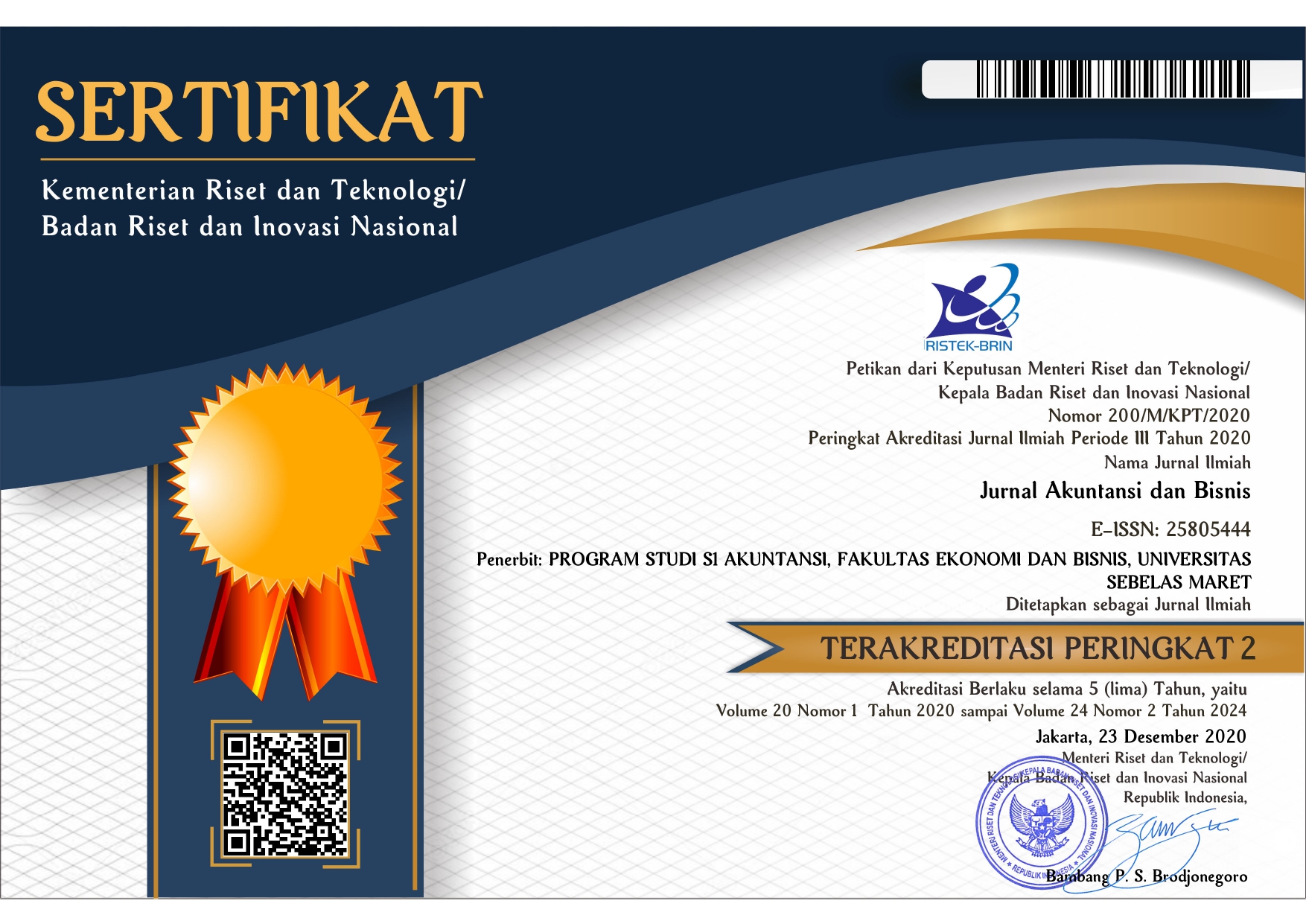Kualitas Laporan Keuangan, Asimetri Informasi dan Efisiensi Investasi
Abstract
Kata kunci : kualitas laporan keuangan, asimetri informasi, efisiensi investasi
Full Text:
PDFReferences
Abel, A., 1983. Optimal investment under uncertainty. American Economic Review, 73, 228–233.
Baker, M., Stein, J., Wurgler, J., 2003. When does the market matter? Stock prices and the investment of equity-dependent firms. Quarterly Journal of Economics,118, 969–1005.
Bernard, V., and D. Skinner. 1996. What motivates managers’ choice of discretionary accruals? Journal of Accounting and Economics 22: 313–325.
Biddle, G., Hilary, G., 2006. Accounting quality and firm-level capital investment. The Accounting Review, 81, 963–982
Biddle, G.C., Hilary, G., Verdi, R.S., 2009. How does financial reporting quality improve investment efficiency? Journal of Accounting and Economincs, 48, 112-131
Biswas, D. 2004 Economics of information in the web economy: towards a new theory? Journal of Bussiness Research, 57(7), 724–33
Blanchard, O., Lopez-de-Silanez, F., Shleifer, A., 1994. What do firms do with cash windfalls? Journal of Financial Economics 36, 337–360.
Bushman, R., Indjejikian, R., 1993. Shareholder demand for ‘‘distorted’’ accounting disclosures. The Accounting Review, 68, 765–782.
Bushman, R., Smith, A., 2001. Financial accounting information and corporate governance. Journal of Accounting and Economics, 31, 237–333.
Chang, X., Dasgupta, S., Hilary, G., 2009. The effect of auditor quality on financing decisions. The Accounting Review, 84, 1085–1117.
Copeland TE, Galai D. 1983. Information effects on the bid–ask spread. Journal of Finance, 38(5):1457–1469.
Dechow, P., Dichev, I., 2002. The quality of accruals and earnings: the role of accrual estimation errors. The Accounting Review, 77, 35–59.
Easley D, Hvidkjaer S, O'Hara M. 2002. Is information risk a determinant of asset returns? Journal of Finance, 57(5), 2185–2221
Fazzari, S., Hubbard, G., Petersen, B., 2000. Investment-cash flow sensitivities are not useful: a comment on Kaplan and Zingales. Quarterly Journal of Economics, 115, 695–705.
Garcia Lara, J. M., Garcia Osma, B., Penalva, F., 2016. Accounting conservatism and firm investment efficiency. Journal of Accounting and Economics, 61, 221-238
Glosten LR, Harris LE. 1988. Estimating the components of the bid–ask spread. Journal of Financial Economics, 21(1),123–42.
Grewala D, Iyerb GR, Krishnanc R, Sharmad A. 2003, The Internet and the price–value–loyalty chain. Journal of Bussiness Research, 56(5),391–398.
Hayashi, F., 1982. Tobin’s marginal q and average q: a neoclassical interpretation. Econometrica, 50, 213–224.
Healy, P., Palepu, K., 2001. Information asymmetry, corporate disclosure, and the capital markets: a review of the empirical disclosure literature. Journal of Accounting and Economics, 31, 405–440.
Holmstrom, B., Tirole, J., 1993. Market liquidity and performance monitoring. Journal of Political Economy, 101, 678–709.
Indonesian Stock Exchange, Fact Book IDX 2016, Jakarta, 2016
Jensen, M., 1986. Agency costs of free cash flow, corporate finance, and takeovers. American Economic Review, 76, 323–329.
Jensen, M., Meckling,W., 1976. Theory of the firm: managerial behavior, agency costs and ownership structure. Journal of Financial Economics, 3, 305–360.
Kanodia, C., Lee, D., 1998. Investment and disclosure: the disciplinary role of periodic performance reports. Journal of Accounting Research, 36, 33–55.
Kaplan, S., Zingales, L., 1997. Do financing constraints explain why investment is correlated with cash-flows? Quarterly Journal of Economics, 112, 169–215.
Kulkarni SP. 2000. The influence of information technology on information asymmetry in product markets. Journal of Bussiness Economics Studies, 6(1), 55–72.
Lambert, R., 2001. Contracting theory and accounting. Journal of Accounting and Economics, 32, 3–87.
Leuz, C., Verrecchia, R., 2000. The economic consequences of increased disclosure. Journal of Accounting Research, 38, 91–124.
Liu, M., Wysocki, P., 2007. Cross-sectional determinants of information quality proxies and cost of capital measures. Working Paper, MIT.
McNichols, M. 2002. Discussion of the quality of accruals and earnings: The role of accrual estimation errors. The Accounting Review, 77 (Supplement): 61–69.
McNichols, M., and P. Wilson. 1988. Evidence of earnings management from the provision for bad debts. Journal of Accounting Research, 26 (Supplement): 1–31
Myers, S., Majluf, N., 1984. Corporate financing and investment decisions when firms have information that investors do not have. Journal of Financial Economics, 13, 187–221.
Stubben, S.R. Discretionary Revenues as Measure of Earnings Management. The Accounting Review, 85(2), 695-717.
Verrecchia, R., 2001. Essays on disclosure. Journal of Accounting and Economics, 32, 91–180.
Yoon, H., Zo, H., Ciganek, A.P. 2011. Does XBRL adoption reduce information asymmetry? Journal of Bussiness Research, 64, 157-163.
Yoshikawa, H., 1980. On the ‘‘q’’ theory of investment. American Economic Review, 70, 739–743.
https://www.bps.go.id/linkTabelStatis/view/id/1317
https://www.bps.go.id/linkTabelStatis/view/id/1318
DOI: http://dx.doi.org/10.20961/jab.v17i1.209
Jurnal Akuntansi dan Bisnis (JAB)
ISSN 1412-0852 (print), 2580-5444 (online)
Published by Accounting Study Program, Faculty of Economics and Business, Universitas Sebelas Maret, Indonesia

JAB on http://jab.fe.uns.ac.id/index.php/jab is licensed under a Creative Commons Attribution-ShareAlike 4.0 International License










